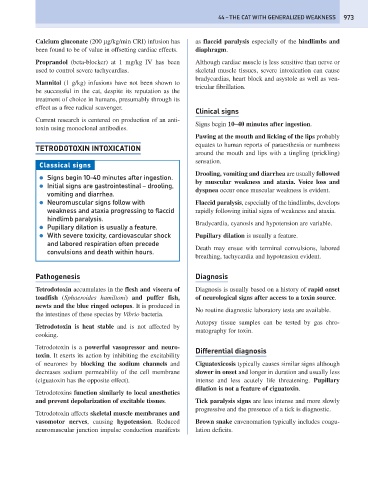Page 981 - Problem-Based Feline Medicine
P. 981
44 – THE CAT WITH GENERALIZED WEAKNESS 973
Calcium gluconate (200 μg/kg/min CRI) infusion has as flaccid paralysis especially of the hindlimbs and
been found to be of value in offsetting cardiac effects. diaphragm.
Proprandol (beta-blocker) at 1 mg/kg IV has been Although cardiac muscle is less sensitive than nerve or
used to control severe tachycardias. skeletal muscle tissues, severe intoxication can cause
bradycardias, heart block and asystole as well as ven-
Mannitol (1 g/kg) infusions have not been shown to
tricular fibrillation.
be successful in the cat, despite its reputation as the
treatment of choice in humans, presumably through its
effect as a free radical scavenger.
Clinical signs
Current research is centered on production of an anti-
Signs begin 10–40 minutes after ingestion.
toxin using monoclonal antibodies.
Pawing at the mouth and licking of the lips probably
equates to human reports of paraesthesia or numbness
TETRODOTOXIN INTOXICATION
around the mouth and lips with a tingling (prickling)
sensation.
Classical signs
Drooling, vomiting and diarrhea are usually followed
● Signs begin 10–40 minutes after ingestion.
by muscular weakness and ataxia. Voice loss and
● Initial signs are gastrointestinal – drooling,
dyspnea occur once muscular weakness is evident.
vomiting and diarrhea.
● Neuromuscular signs follow with Flaccid paralysis, especially of the hindlimbs, develops
weakness and ataxia progressing to flaccid rapidly following initial signs of weakness and ataxia.
hindlimb paralysis.
Bradycardia, cyanosis and hypotension are variable.
● Pupillary dilation is usually a feature.
● With severe toxicity, cardiovascular shock Pupillary dilation is usually a feature.
and labored respiration often precede
Death may ensue with terminal convulsions, labored
convulsions and death within hours.
breathing, tachycardia and hypotension evident.
Pathogenesis Diagnosis
Tetrodotoxin accumulates in the flesh and viscera of Diagnosis is usually based on a history of rapid onset
toadfish (Sphaeroides hamiltoni) and puffer fish, of neurological signs after access to a toxin source.
newts and the blue ringed octopus. It is produced in
No routine diagnostic laboratory tests are available.
the intestines of these species by Vibrio bacteria.
Autopsy tissue samples can be tested by gas chro-
Tetrodotoxin is heat stable and is not affected by
matography for toxin.
cooking.
Tetrodotoxin is a powerful vasopressor and neuro-
Differential diagnosis
toxin. It exerts its action by inhibiting the excitability
of neurones by blocking the sodium channels and Ciguatoxicosis typically causes similar signs although
decreases sodium permeability of the cell membrane slower in onset and longer in duration and usually less
(ciguatoxin has the opposite effect). intense and less acutely life threatening. Pupillary
dilation is not a feature of ciguatoxin.
Tetrodotoxins function similarly to local anesthetics
and prevent depolarization of excitable tissues. Tick paralysis signs are less intense and more slowly
progressive and the presence of a tick is diagnostic.
Tetrodotoxin affects skeletal muscle membranes and
vasomotor nerves, causing hypotension. Reduced Brown snake envenomation typically includes coagu-
neuromuscular junction impulse conduction manifests lation deficits.

